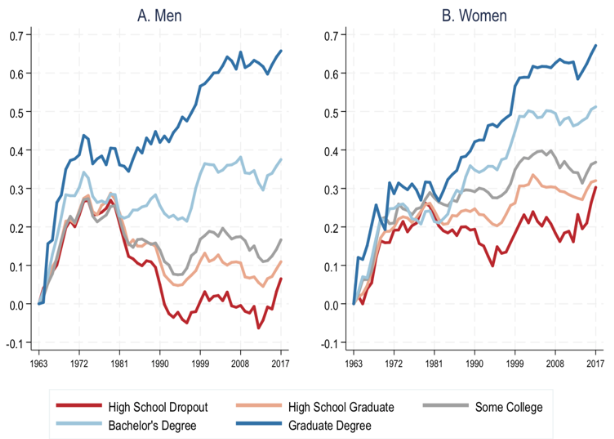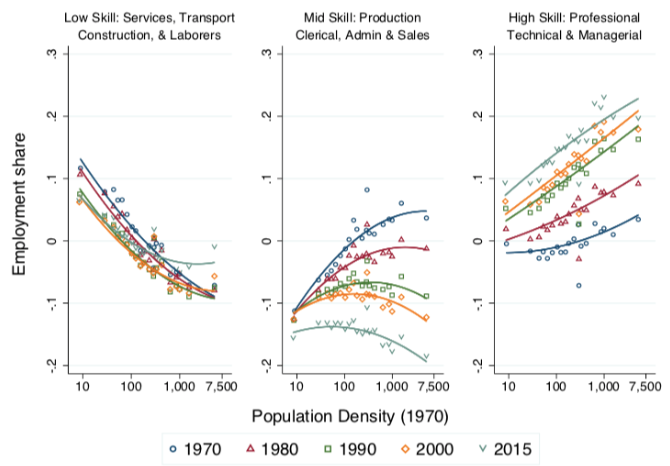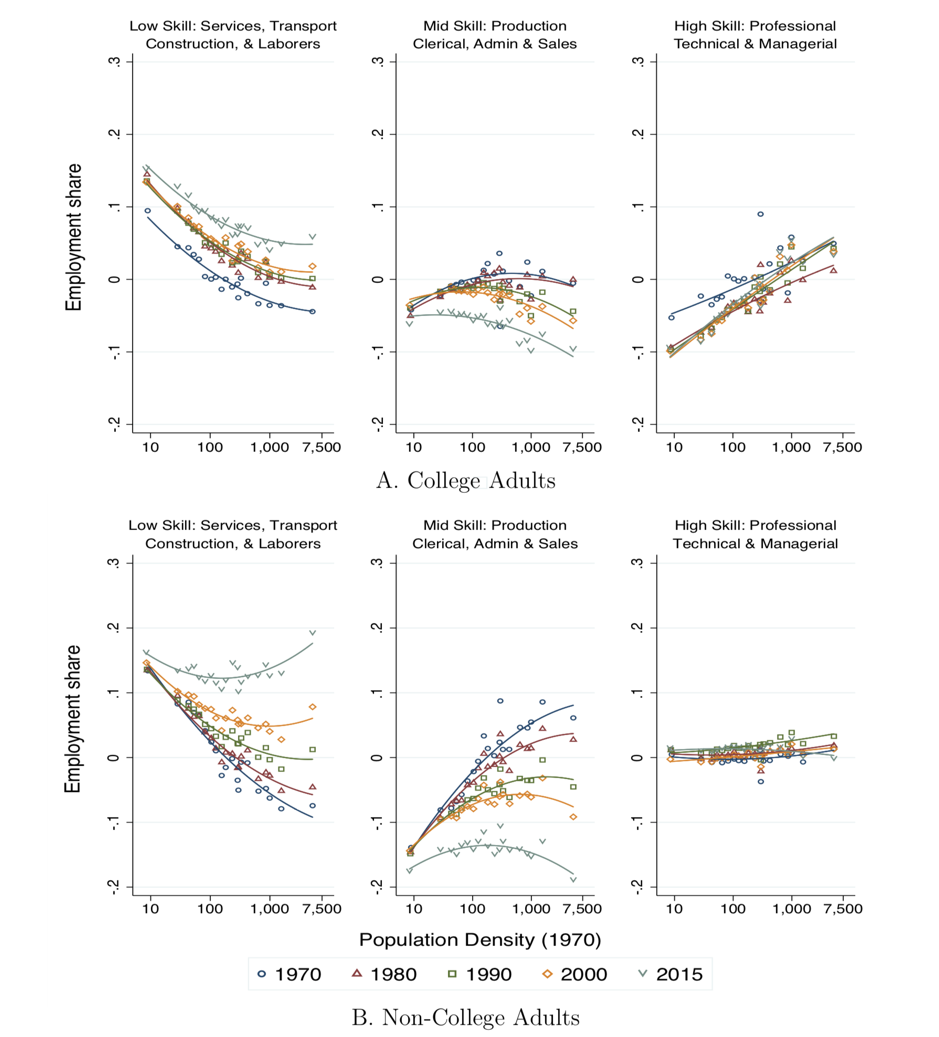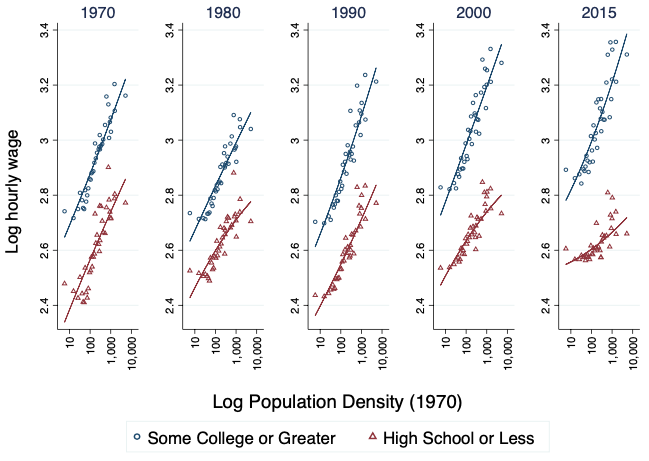By David Autor, Ford Professor, MIT Department of Economics. Originally published at VoxEU
Labour markets in US cities today are vastly more educated and skill-intensive than they were 50 years ago, but urban non-college workers now perform much less skilled work than they did. This column shows that automation and international trade have eliminated many of the mid-skilled non-college jobs that were disproportionately based in cities. This has contributed to a secular fall in real non-college wages.
In the last 40 years, less-educated workers in most advanced economies have experienced a sustained fall in real wages. (Dustmann et al. 2009, Acemoglu and Autor 2011, Blundell et al. 2018). In the US, for example, wages have risen robustly among the most-educated workers, but since 1980 they have fallen in real terms among men with no college education (Figure 1).
Figure 1 Cumulative change in real weekly earnings of working age adults 18-64, 1963- 2017

Source: Autor (2019), based on Current Population Survey (CPS) Annual Social and Economic Supplement.
There are many potential explanations for this, including eroding union penetration and bargaining power, falling federal and state minimum wages, rising trade pressure stemming from China’s rise as a manufacturing power, and changes in employer practices that decouple the wages of less-educated workers from the productivity and profitability gains of their employers (Card 1996, Lee 1999, Autor et al. 2013, Weil 2014, Autor et al. 2016).
In recent work (Autor 2019), I document another force that has contributed to the declining fortunes of less-educated workers: the rapid erosion of middle-skill employment – both production work and administrative and clerical work – among non-college workers in high-wage urban labour markets.
Many readers will be familiar with the occupational polarisation that has reshaped the landscape of work among less-educated workers: CPS data tell us that in 1980, US employment of non-college workers was roughly split between low- and middle-skill occupations, with 42% in the former category, 43% in the latter, and the remaining 15% in high-skill occupations. Broadly, these groups are: (low-skill) service and manual occupations; (mid-skill) production, office, administrative, and sales occupations; and (high-skill) technical, professional, and managerial occupations. In the intervening (nearly) four decades, the share of non-college employment in middle-skill occupations fell from 43% to 29%. The share in high-skill occupations increased only slightly (15.4% to 16.8%), and so most of the decline in non-college middle-skill employment is proximately explained by the movement of non-college workers into traditionally low-educated, low-paid work. In contrast, for college-educated workers, the decline in middle-skill employment has resulted in an equal outflow into high- and low-skill occupations.
But does occupational change explain the post-1980 divergence in real wages by education (see Figure 1)? A short answer is no. A simple counterfactual exercise that holds the occupational wage structure fixed while allowing the distribution of workers by education and gender to shift across occupations as occurs in the data shows that only a small fraction of the divergence in the data is accounted for by simple movements of education and gender groups across occupations. Thus, changing occupational composition cannot by itself explain most of the evolution of wage inequality between groups. Something else is happening.
The Decline of Middle-Skill jobs in Urban Areas
The structure of work differs systematically across places, and one of the key predictors of occupational structure is population density. Some activities, such as agriculture, naturally take place in low-density areas, but knowledge-intensive industries tend to locate in cities, where educated workers are most concentrated (Glaeser and Mare 2001, Moretti 2004, Berry and Glaeser 2005).
In the decades following WWII, there was a steep positive urban gradient in the skill and wage levels of workers in non-college jobs in the US. Non-college urban adults disproportionately held middle-skill, blue-collar production and white-collar office, administrative, and clerical jobs. These workers laboured in close collaboration with the high-skill, urban professional, managerial, and technical workers who oversaw factories and offices. This meant that middle-skill jobs for non-college workers were prevalent in cities and metropolitan areas, but scarce in suburbs and rural labour markets.
Figure 2 depicts the aggregate relationship between population density and occupational structure at the level of 722 commuting zones (CZs) covering the contiguous US states between 1970 and 2015.
The three panels of this figure report the CZ-level share of employment among working-age adults into the three broad occupational categories described above: traditionally low-education, low-wage services, transportation, labourer, and construction workers; traditionally mid-education, middle-wage occupations made up of clerical, administrative support, sales, and production workers; and high-education, high-wage, professional, technical, and managerial workers.
The horizontal axis is the natural log of population density (the number of residents divided by CZ land area). For consistency, I used each zone’s population density in 1970 throughout, and the data are weighted by the count of working-age adults in each CZ. Each plotted point in the bin-scatter represents approximately 5% of all workers in each year.
The rising set of upward-sloping curves in the right panel show that while denser CZs have traditionally been more intensive in high-skill work, the level and slope of this relationship between density and skill-intensity has risen consistently over multiple decades. The overlapping downward-sloping curves in the left panel show that the fraction of workers engaged in low-skill occupations has historically been much smaller in high-density CZs, and this pattern has changed little over decades. In the middle panel, the fan-shaped set of curves show that the denser CZs were exceptional in the 1970s for having far more middle-skill work than suburban and rural CZs. But this exceptional feature attenuated. By 2015, the densest CZs had less middle-skill work than the suburbs or rural areas.
Figure 2 Occupational employment shares among working-age adults by commuting zone population density, 1970-2015

Source: Autor (2019), based on US Census for 1970, 1980, 1990, and 2000, and pooled American Community Survey data for 2014-2016.
We can decompose this into the different experiences of college-educated and non-college-educated adults (Figure 3). For college-educated adults, there was a decline of about eight percentage points in the share of college workers working in middle-skill occupations, and this shift was most pronounced in denser CZs. For non-college workers, at no point was there any meaningful density gradient in high-skill work among non-college workers. But in 1970 non-college workers in the densest CZs were approximately 25 percentage points more likely to work in middle-skill occupations than those in low density CZs. By 2015, the low-skill employment share among non-college workers was several points higher in the most- versus the least-dense CZs, while the middle-skill employment share was several points lower.
Figure 3 Occupational employment shares among working-age adults by commuting zone population density for college and non-college adults, 1970-2015

Source: Autor (2019), based on US Census for 1970, 1980, 1990, and 2000, and pooled American Community Survey data for 2014-2016.
Where have all of these middle-skill jobs gone? Two secular demand-side forces have contributed substantially to their disappearance (Autor and Dorn 2013, Autor et al. 2016, Acemoglu and Restrepo 2017): one is the decline of manufacturing production work in the face of automation and rising trade pressure; the second is the proliferation of increasingly capable and user-friendly office computing tools that have reduced demand for workers in routine office tasks. While manufacturing had already departed the densest urban areas by the 1970s, the march of office computing has been particularly significant for urban, non-college workers. In 1980, the share of non-college workers in clerical and administrative occupations was 15-plus percentage points higher in the most versus least dense CZs. As office computing capabilities advanced, clerical and administrative employment among non-college workers fell steeply from the 1980s onwards. By 2015, there was almost no remaining (positive) density gradient in office work among non-college workers.
Wage Polarisation Has Been Disproportionately Urban
It is a robust empirical regularity that urban workers earn more than observably similar non-urban workers (Glaeser and Mare 2001, Moretti 2004, Glaeser and Resseger 2010). Given that land prices are intrinsically higher in dense locations, it is logical that higher urban wages compensate workers for the higher cost of urban living (holding amenities constant). For this to be an equilibrium, however, the productivity of urban workers must also be commensurately higher; otherwise, firms would locate elsewhere.
It is easy to imagine why urban productivity is greater for highly educated workers. In knowledge-intensive work, in-person interactions appear to have few close substitutes, meaning that proximity is critical. It is less obvious, however, why these productivity spillovers accrue to less-educated workers – but historically they clearly did so. One possibility suggested by the evidence above is that, in past decades, less-educated workers performed higher-skilled work in urban areas – specifically, production, clerical, and administrative jobs. If so, the secular decline of middle-skill urban occupations might have served to depress the urban wage premium among non-college workers.
Figure 4 Real log hourly wages among college and non-college adults, 1970–2015

Source: Autor (2019), based on US Census for 1970, 1980, 1990, and 2000, and pooled American Community Survey data for 2014-2016.
Figure 4 shows that this has indeed occurred. Between 1990 and 2015, the urban wage premium among non-college workers declined by roughly two thirds, even as the urban wage premium among college workers steepened. A similar pattern is documented by Baum-Snow et al. (2018). As I demonstrate in Autor (2019), this striking pattern is not driven by other obvious confounds such as changes in age structure in urban areas, shifts in the educational composition of the broad ‘non-college’ category, lingering after-effects of the Great Recession, or artefacts of the rising immigrant share of urban workers. Rather, it appears to be a genuine change in urban wage structures. In short, occupational polarisation has disproportionately occurred in high-wage urban and metro labour markets, and it appears likely that the geography of polarisation has magnified its wage impacts.
Conclusion
Non-college workers in US cities perform substantially less skilled work than they did four decades ago. This change reflects the effects of automation and, to a lesser degree, international trade, which have eliminated the bulk of non-college production, administrative support, and clerical jobs, yielding a disproportionate polarization of urban labour markets. The unwinding of the urban non-college occupational skill gradient has shunted non-college workers out of specialised middle-skill occupations into low-wage occupations, diminished the set of non-college workers that hold middle-skill jobs in high-wage cities, and attenuated the steep urban wage premium for non-college workers that prevailed in earlier decades. Changes in the nature of work – many of which are technological in origin – have been more disruptive and less beneficial for non-college than college workers.
See original post for references


which is the reason that the US needs a point-based/skills/degrees-based migration system. the US has a near permanent trans-identity non-skilled worker class who need help first.
but i’m not holding my breath as that’s the third rail of progressive politics–among many.
“worker class who need help first”
Sorry, but the Kochtopus has other plans:
Schar School receives $1.1 million from the Koch Foundation for research on immigration, labor markets
The family preference visas are capped at 480k per year. The Diversity Visa Lottery is only about 50k visas a year. That’s 530k per year, which is not insignificant, but I don’t know how many are “low skilled.”
The H1B temporary visa is capped at 85,000 per year.
If you’re referring to refugees, the US government already has a legal as well as moral obligation to take them which it is failing to fulfill anyway. I’m upset that so many immigration advocates have tried to muddy the distinction between refugees and other immigrants.
Of all the headwinds American workers are facing, legal immigration does not seem like a very great one.
As for illegal immigration, it’s already illegal. If the government doesn’t want to pursue charges against all the American businesses that are recruiting people to be smuggled into the country, that’s another issue.
I suspect that the higher wages urban areas for low skilled jobs are simply a matter of increased competition for workers. The low wage workers can more easily find other employment than those in low density areas. Fewer of them are going to be stuck in a crappy job with nothing else in a reasonable commute.
I like David Autor’s work a lot. He has been one of the few economists to not just talk about data, statistics, and economic models, but to actually connect the research to social justice issues such as impacts on workers from globalization.
http://www.nber.org/papers/w21906.pdf
http://economics.mit.edu/files/7723
Unfortunately, my reading of the above post seems to be your standard economist presenting data, statistics, and nice graphs without connecting the dots. Autor seems to even walk back previous assertions of the considerable impact of trade with China on the manufacturing jobs in the US, which is mentioned in the above links.
====Changes in the nature of work – many of which are technological in origin – have been more disruptive and less beneficial for non-college than college workers====
Autor’s research on the effect of trade with China on the exodus of manufacturing jobs in the US seems to be in conflict with his conclusion above that now states it is automation and technology.
No matter what a person believes about the changes in the nature of work, globalization or automation, the important point which Autor’s post above misses is that these “changes” did not just fall from the sky. These “changes” were probably not chosen by the “people” i.e. democratic vote. The changing nature of work was due to policy decisions in government, and business and corporate decisions (without govt. input) that affected millions of workers. As Lambert has mentioned many times, the US lacks any semblance of an industrial policy. The lack of industrial policy is a conscious choice of the government and corporations, and not the the workers who are severely impact by the gutting of the US manufacturing base.
Two more observations. One is Autor seems to place too much emphasis on the “college premium”. The post above and the conclusions could be applied to many people with a college degree as well. There are many people with college degrees who are grossly underemployed or not working at all. This is indicated by the feeding frenzy in the recent college admissions scandal. You do not just need a college degree (there is an excess supply of college degreed people), a person needs a degree from the elite colleges to have a chance at the Hunger Games competition that looking for a good job has become.
Secondly, this over focus on “college vs. non-college” also assumes there is some special characteristics or character traits that college degreed people possess. This could not be further from the truth. I have known many people who have a bachelors, masters, or doctorate degrees that are as dense as a brick and lack any common sense or problem solving ability. Educational reformers such as Ivan Illich and John Taylor Gatto have discussed the need for more vocational, hands on, and apprenticeship type education.
The post above is akin to Lambert’s recent quote, ” I see your house is on fire, and I am here to listen”. Or the economist version, ” I see your house is on fire, and I am here to offer data, models, and graphs”.
Re “There are many potential explanations for this, including eroding union penetration and bargaining power… (my emphasis).” This is stated as if this union diminishment were a natural phenomenon, like riverbed erosion, rather than due to massive opposition by the plutocrats. Reinstating the rights of unions is part of the solution to the imbalance of power created by the plutocrats.
I’m just wondering here – looking at the horrors already upon us with climate change, specifically Nebraska’s road system being totally devastated by flooding – aren’t there going to be real, immediate needs for some kind of civilian conservation corps to cope with the extremes we know are coming?
Won’t be a need for techies; will be a need for all hands on deck.
The problem is those jobs require a high degree of skill too, and way too few people go into the trades to learn how to build roads anymore. Or anything else infrastructure related.
Heck, I just spent all day on my roof because the last owners either had no idea what they were doing or the contractors they hired had no idea what they were doing. Basic skills like how to swing a hammer or make something water tight are missing in society. Advanced skills like laying down a road bed to meet a spec grade with the right materials are also missing. Ditto for intermediate skills like rough plumbing or building forms for concrete pours.
Before we get to a place where we could have another go at a CCC, or a WPA, we need a practical skills teachers corps that can show all these people who have never done that kind of work how to do it.
I’m not holding my breath we’ll see anything like that ever. I’m also not optimistic that the majority of the populace wants to learn how to do these things. Even if it’s to work on their own property.
Chris, not many of the people who have the skills you describe can afford their own homes.
Still, at least construction still teaches it’s members. If someone wants those skills, they can get a job and learn there.
I will say teaching someone how to make something watertight is a lot harder than it should be, though….
See, the problem is, these skills didn’t used to be unique to the construction trades. Everyone knew how to use a saw, dig a hole, etc. People in construction were supposed to be better at those things, plus know other skills, and be more efficient and knowledgeable in those areas. In my opinion it’s just as worthwhile to make sure children learn these skills as anything like coding. And just like how an understanding of coding is being pushed at all levels, basic life skills like using a hammer and choosing the right nail should be pushed at all levels.
In my experience, which is of course limited given the populace we’re discussing, the people with those skills are more likely to own their own property because the maintenance costs for them are substantially lower and because they can buy cheaper property which they renovate.
Its frightening to walk around a Home Depot and see all these people buying things that they don’t know how to use and that might do serious damage to themselves. Or others!
The author stated this in his intro but basically ignored it in the rest of the article; “changes in employer practices that decouple the wages of less-educated workers from the productivity and profitability gains of their employers”. I would append to that statement “government practices ” as well as “employer practices”. Since the 70’s government and business have made a concerted effort to weaken labor and citizen rights. Everything else the author discussed here could have been prevented if we had a government that was concerned about the general populations welfare instead of making the wealthy more rich.